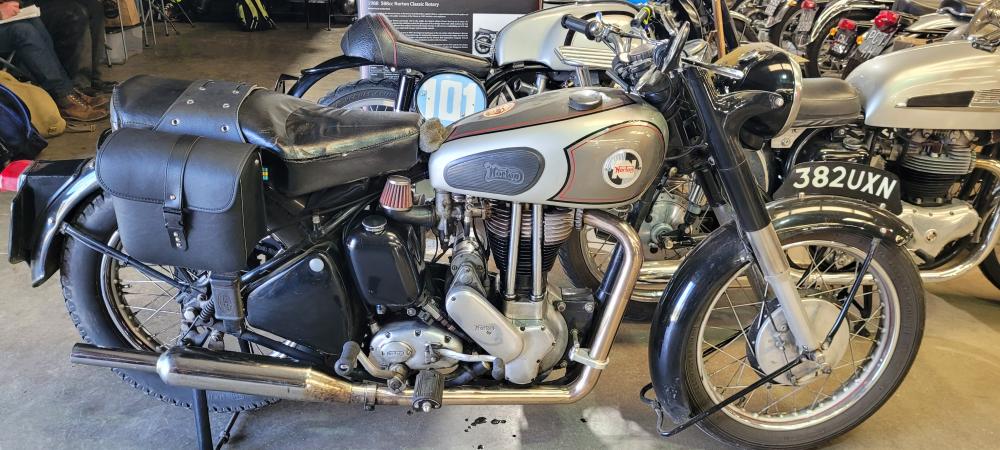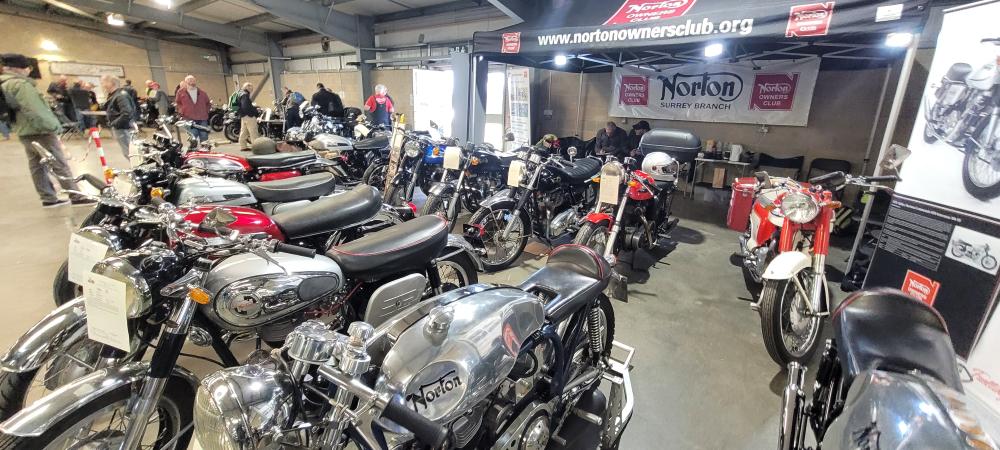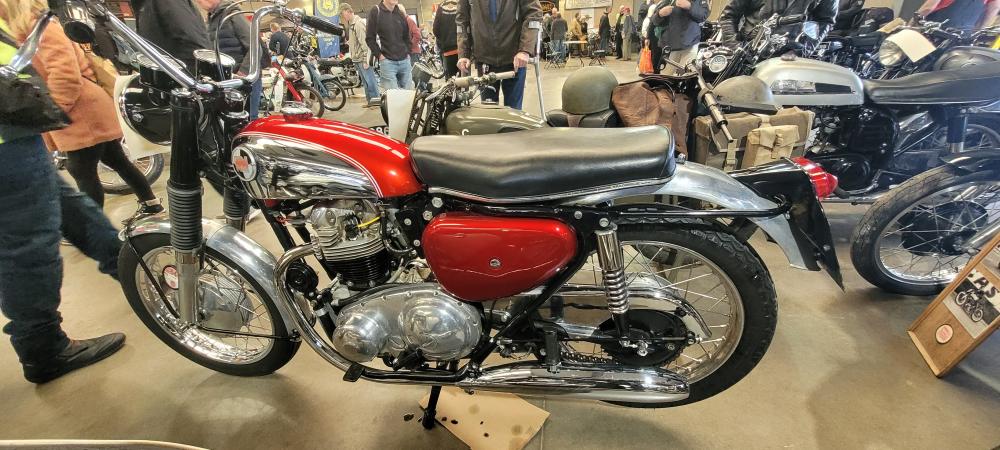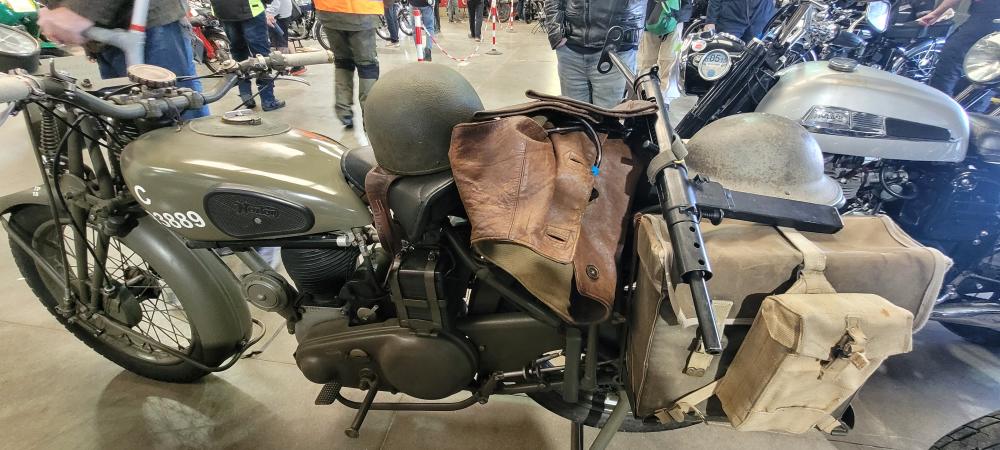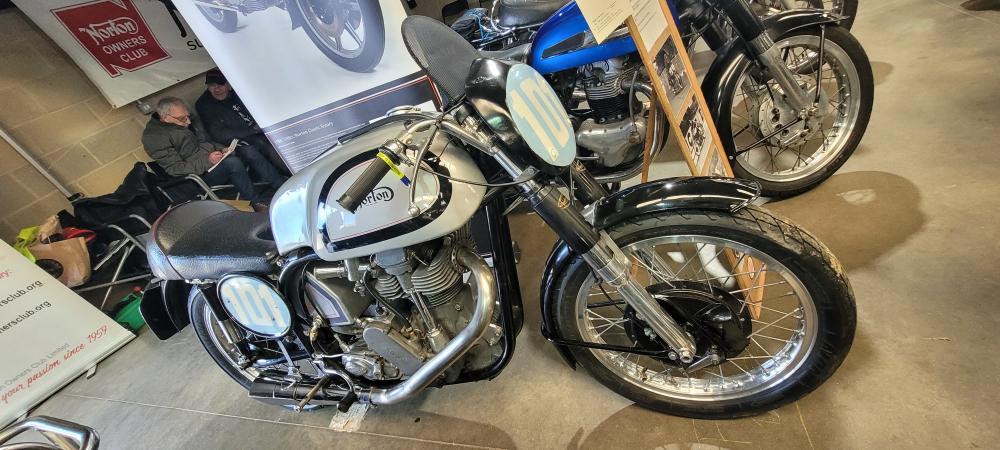A review of correspondence from Roadholder and NOC-L
About the virtues of replacing the standard Commando head steady with one
of the 'Norvil' types; and the differences between the two versions available
Side plate modification to restrict lateral movement
A real cut price improvement on your head steady is to junk the two side plates and replace them with copies made from 7mm alloy plate. It squashes the rubber a bit and transmits a bit more vibration, but helps control lateral movement.
L.S.D. Taylor (lsd.taylor2@virgin.net) on NOC-L 25th. Apr 1997
Side plate modification - confirmation that it works
Ditto that [see above - Editor]. The side plates on my headsteady didn't hold up very well. Too thin and not enough material around the upper mounting holes. I had plates made of 3/16" stainless with about 1/4" more metal on top. Also, the fitting is important. The plates not only need to be spaced accurately for gap, but they need to be parallel with the centerline of the bike. You may (will) have to mill, or file, or shim with washers to get it right, but you will notice a big difference.
Bob Patton (bpatton@humboldt1.com) on NOC-L 5th. May 1997
Norvil head steady - useful for hard riding
The Norvil head steady (top motor mount for those who speak
American,) is a racing part which has been used on the street. If you are going
to be using the bike for racing, or are the sort of street rider who scratches
round all the bends, scraping the footpegs as you go, the Norvil part is for
you. If, on the other hand, you are like most of us, who ride more sedately and
are looking for a comfortable and vibration free ride, keep the stock item. The
Mk.lll head steady was improved over the earlier models, and should be good
enough for all but the most outrageous street riding.
Another problem
with the Norvil item is that it is supposed to only fit under the Interstate and
Proddy-race tanks. It may cause problems if you ride a Roadster or Hi-Rider.
Colin Sharpe (sharpe_colin@videojet.com) on NOC-L 21st. May 1997
Head steady fitting problems due to poor tolerances; handling improvement debatable
On my Commando, the production racer head steady was impossible
to fit correctly. I measured the width of the assembled mount at each of the
three bolting holes, and then made adjustments to make all three measurements
the same. In practice this involved narrowing the inner isolastic tube with a
mill file, and finding 5/16" washers of just the right thickness to shim the
frame mounts. Thus these two points arrived at the same width as the bracket
that clamps to the small frame bracing tube. The worst variation, and one that
the supplier could not precisely account for, was that my frame was narrower at
the original single head steady mounts. Once this was done, I could properly
adjust clearance with shims just like the standard mounts. In operation, I found
that at the extremes of engine movement, the steady actually hit the frame, and
hard. Taking it apart again, the point of contact was well marked! I used a
half-round file to relieve the steady (the main tube that actually contains the
isolastic rubbers). I gave it around 1/4" more clearance. It still hits, but now
you only hear it (rap!) instead of feeling it (BHRANGK!), and only at about 2500
rpm. If you expect parts to fit correctly out of the box and to come with useful
instructions, you will not be happy.
On the road, the improvement in
handling is of debatable value, and the increase in vibration is significant.
The "sweet spot" of ultra smooth operation is much narrowed to the mid-high
3000s rpm. Under 3000 rpm, vibration is really awful compared to the Mk.lll head
steady I had been using. So, I notice the difference much more around town than
on the open road; and it is either getting better or I am getting used to it,
partly by changing my habits to use lower gears and more revs around town.
Is the bike steadier in situations that reveal handling faults? I got it
in hopes of improving behaviour during hard cornering on rough pavement at
speeds over 70 mph. It is better. Although it is also reasonable to expect that
wear on the front mount will be reduced, I do not recommend it unless you are
prepared to be creative adapting it to fit, and do a lot of high speed work.
Ben English (ben.english@DMVMS.mailnet.state.ny.us) on NOC-L 22nd. May 1997
Norvil head steady - no longer sure
Many thanks for the evaluation of the kit [Norvil]. It confirmed my worst fears about the thing. I'd been thinking about getting one, but had been uneasy about whether it made things better or worse. Sounds to me like it made things worse.
Gregg Kricorissian (grkricor@ccs.carleton.ca) on NOC-L 23rd. May 1997
Norvil head steady - debatable handling improvement confirmed
|
"On the road, the improvement in handling is of debatable value, and the increase in vibration is significant" - Ben English |
I concur: this is the same experience I have had with these [Norvil] items. Your cash could probably be put to much better use elsewhere on the bike. If you are experiencing high speed handling problems with your Commando, check your tyres, Isolastic clearance and swinging arm pivot.
Gary Slabaugh (gdslabaugh@sprintmail.com) on NOC-L 23rd. May 1997
Norvil head steady - no installation problems and a considerable handling improvement
The Norvil head steady I purchased from Walridge Motors was easy to install & seemed to tighten up the handling considerably with only a minor increase in vibration.
Guy Fortier (fortierg@adan.kingston.net) on NOC-L 24th. May 1997
Mk.lll head steady
Speaking of Mk.lll head steadies, I've been using one for years and when I got it, Brian Slark of British Marketing told me over the phone not to bother with the spring contraption, since that was a bodge designed to hold up the heavier 850 engine in the Isolastics. I never did bother with it, but now I'm wondering whether some degree of spring might be useful on a 750 engine. Has anyone experimented with using the spring (or a weaker spring) on a 750, and what was the result?
Mike Taglieri (miketnyc@juno.com) on NOC-L 24th. May 1997
Comparison of two Norvil head steadies; some improvement in handling
I have no doubt that there are differences in the goods supplied by the two purveyors of Norvil replica parts. As to fit, this depends to some degree on the width of one's frame at the original head steady rubber mounts. I would be surprised if this does not vary ± 0.040" from frame to frame, but must be within ± 0.001" of the Norvil's two mounting points for a good fit. I can detect no difference in handling at sensible speeds (no improvement needed there). Riding as fast as I dare, there is significant but not overwhelming improvement. The vibration, as I said, is getting better (or I am getting used to it).
Ben English (ben.english@DMVMS.mailnet.state.ny.us) on NOC-L 27th. May 1997
Another comparison of two Norvil head steadies; handling improved
Several people have said that the Norvil (Isolastic) head
steadies do not fit under Hi-Rider and some other tanks. I have two of the
Norvil headsteadies; one is from Fair Spares and the other from Mick Hemmings.
The one from Mick Hemmings is not as wide as the other and it will fit under
anything.
I think both work quite well, I don't find the vibration much
worse than with the regular head steady and I also find the handling benefits
worth it.
Brian Tyree (mcdonald.tyree@worldnet.att.net) on NOC-L 31st. May 1997
Norvil head steady - vibration reduced considerably after refitting properly
Last night, after getting a perfect 0.010" clearance by adding
0.010" to my front isolastic, I relieved another 1/16" (my original work really
only gained 1/8", not 1/4" as stated) off the top of the Norvil housing, and
reassembled, the 0.005" shim making it perhaps 0.001" tight (only in one spot -
the side plates are still not perfectly parallel, despite previous fiddling, but
it's about as good as I feel like making it.)
What a difference! I
underestimated how much the steady was hitting the frame. It had to have been
making contact from just off idle to the low 3000s r.p.m., depending on
throttle. Both noise and vibration are much reduced. I can now ride at 1500-3100
r.p.m. without feeling my hands will go to sleep, if the handlebar doesn't break
first.
Ben English (ben.english@DMVMS.mailnet.state.ny.us) on NOC-L 30th. July 1997
Old style vs. new style head steady
| Will the head steady from my 1970 Commando work with a 1973 motor in the 1970 frame? |
Get the 850 headsteady - the original 750 style is a junky
steel stamping that had stress cracks from the factory. When it breaks (not if)
every turn will feel like the front wheel is coming off. It's the stress of
turning that the headsteady has to resist, so you'll probably be in the middle
of a high-speed turn when it finally snaps in half.
If you don't want
all this excitement, get an 850 style box headsteady, which you can find used
because they're indestructible. It goes on the same, and the only problem is
that it's a pain to tighten the middle Allen bolt on the head. I wound up
cutting a piece of Allen wrench just long enough to go into the bolt and still
clear the frame tube, so now I can get a wrench on that to tighten the middle
bolt.
Mike Taglieri (miketnyc@juno.com) on NOC-L 30th. Jun 1998
Leave out the awkward Allen bolt
I haven't found it necessary to put the middle Allen key bolt in; it works fine with 2 bolts. Does it make that much difference?
Pete (ipdream@nettrade.com.au) on NOC-L 30th. Jun 1998
Special Allen screw
A bloke in Tasmania makes an special Allen screw to circumvent this problem. It's like one screw sitting on top of another, or maybe better described as a long Allen screw with a shoulder half way up the shank. The effect is to put the socket up within sight and reach. If anyone is interested we might be able to arrange a supply.
Chris Ghent (we@amaze.net.au) on NOC-L 30th. Jun 1998
Leave out the awkward Allen bolt
I also have been leaving out the pesky center bolt in the headsteady. It's easier and cheaper than special bolts or special tools to use on them.
Gary Slabaugh (gdslabaugh@sprintmail.com) on NOC-L 30th. Jun 1998
Do not leave out the awkward Allen bolt
In a production environment such as making motorcycles, ease of
assembly is something to which attention is paid. If the hard-to-assemble centre
bolt is not necessary, why did Norton make a hole in the steady, make a hole in
the head and tap it, and put an extra screw in to hold everything in place?
I think that for a critical part such as this, it is worth the trouble
of putting the centre bolt in. After all, you shouldn't need to do it more than
once every 25,000 miles! You certainly wouldn't want the steady loosening off;
the results would once again be just as Mike and I described for a broken head
steady.
Colin Sharpe (sharpe_colin@videojet.com) on NOC-L 30th. Jun 1998
A fix for the awkward centre bolt
I've used a hex socket with a pair of vice grips on the exposed top of socket body to gain access to this pain of a bolt.
Mike Sarbacker (msarback@ma.ultranet.com) on NOC-L 30th. Jun 1998
Do not leave out the awkward Allen bolt
I am inclined to agree with Colin on this one and I for one will not knowingly leave out any fasteners which the factory deemed worth fitting originally.
Martin Edridge (martin.edridge@rcn.org.uk) on NOC-L 30th. Jun 1998
Another fix for the awkward centre bolt
My socket has a 3/16" hole drilled through its side, so you can insert a suitably sized screw driver or equivalent tommy-bar and tighten it up with that.
Richard Bates (richard.bates@thomasmiller.com) on NOC-L 30th. Jun 1998
Experience with one type of head steady
I have been using a Norvil Motorcycle Co. stainless steel head
steady for 12 years. now. It fits well, although I heard there was a batch
wrongly drilled. It is slimmer than the original ones and therefore fits
underneath all tanks. The original side plates were made from alloy but they
wore quickly and so I prefer the ones with steel side plates. The side plates on
this example seem to be not thick enough and tend to bend, so it is better make
your own ones.
It is also rather tricky to tighten the centre bolt, even
with a shortened allen key, as you can screw only 1/6 turn each time. The cure
is to grind a groove into the isolastics tube (without cutting through!) so the
place above the screw has free access for the allen key. A further advantage is
that the longer key isn't blocked any more by the welded plates that connect the
tube and bottom plate, so there is more 'turn range'. I recommend that the
headsteady is fitted with the bike on its wheels and side stand. so that the
main weight is put on the standard isolastics; then the upper rubbers will last
longer.
Hendrik Zeugke (h.zeugke@fh-wolfenbuettel.de) on NOC-L 25th. Jan 1999
Another home made head steady
I've never really tried a Norvil head steady, but I replaced the head steady side plates on my Mk.lll with 8mm thick dural, and there is an improvement. My theory is that most of the movement comes from the original plates acting like a diaphragm. I later shimmed the bobbins to nip them a bit more. I found little improvement and a lot more vibration. It's cheap and simple; give it a try before splashing out on an expensive head steady.
Dave T. (david@purdydog.freeserve.co.uk) on NOC-L 29th. Jan 1999

